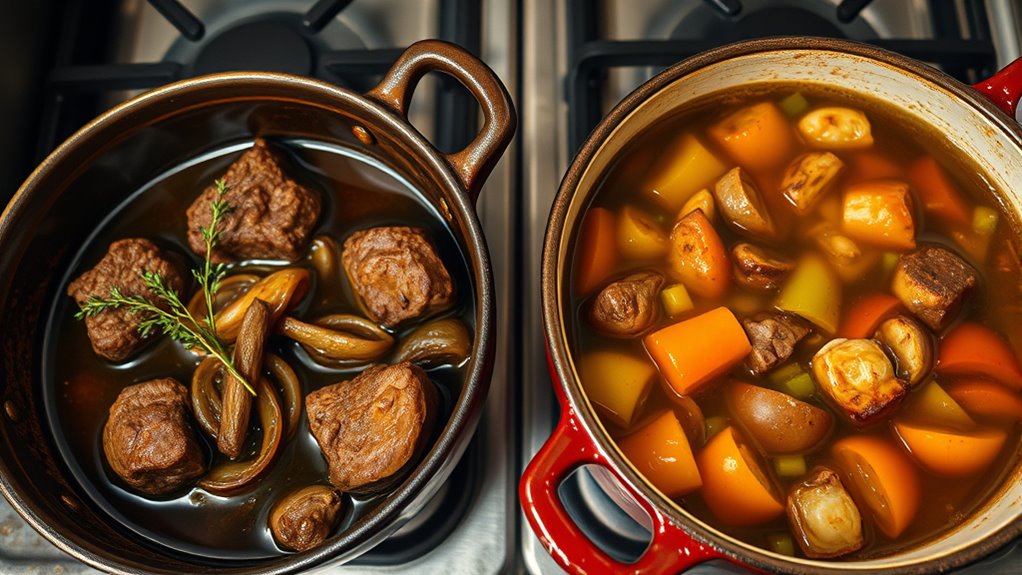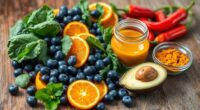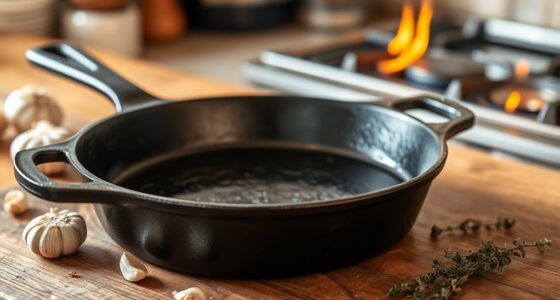Braising and stewing are both slow-cooking methods that make your meals tender and flavorful, but they differ in technique. Braising involves cooking larger, tougher cuts at lower temperatures (275°F to 325°F) for longer periods, resulting in fall-apart meat with rich sauces. Stewing uses smaller pieces, cooked at slightly higher temperatures (200°F to 250°F), for a shorter time, yielding uniformly tender bites in a thick broth. Learn more to perfect each method for your favorite dishes.
Key Takeaways
- Braising uses larger cuts at lower temperatures (275°F–325°F), while stewing involves smaller pieces cooked at slightly higher temperatures (200°F–250°F).
- Braising requires longer cooking times (1.5–3+ hours), whereas stewing generally takes 1–2 hours for tender, flavorful results.
- Larger cuts in braising develop rich flavors and tenderize through collagen breakdown, producing melt-in-your-mouth textures.
- Smaller, uniformly cut ingredients in stewing cook faster, yielding tender pieces with concentrated broth.
- Both methods create flavorful, tender dishes but differ in temperature, cut size, and cooking duration to achieve desired textures.

When it comes to cooking tender, flavorful meats, braising and stewing are two popular methods that often get confused. Both techniques involve slow cooking in liquid, but they differ primarily in cooking temperature and duration, which directly impact the final texture and flavor of your dish. Understanding these differences helps you choose the right method for your ingredients and desired outcome.
Braising and stewing both involve slow cooking in liquid but differ in temperature and cut size for desired tenderness.
Braising typically involves cooking larger cuts of meat or tougher ingredients at a relatively low temperature, usually around 275°F to 325°F (135°C to 160°C). The cooking temperature is moderate enough to gently break down connective tissues without boiling, which helps preserve moisture and develop rich flavors. The cooking duration for braising can range from 1.5 to 3 hours or even longer, depending on the size and toughness of the cut. This extended, slow process allows collagen to convert into gelatin, resulting in melt-in-your-mouth tenderness and a deeply flavored sauce formed from the cooking liquids.
Stewing, on the other hand, generally involves smaller, uniformly cut pieces of meat or vegetables. The cooking temperature is slightly higher, often maintained just below boiling point, around 200°F to 250°F (93°C to 121°C). Because the ingredients are cut into smaller pieces, they cook faster, generally within 1 to 2 hours. The higher temperature accelerates the breakdown of tissues, making stewing a quicker method than braising. The smaller pieces also mean the dish develops a different texture—more uniform and tender, but not as fall-apart soft as braised meat. Stewing produces a hearty, thick liquid that closely envelops the ingredients, ensuring each bite is flavorful.
Both methods rely on slow, moist heat, but their key distinction lies in cooking temperature and duration. Braising’s lower temperature and longer cooking time allow for a gradual transformation of tougher cuts into tender, flavorful meat with a rich sauce. Conversely, stewing’s slightly higher temperature and shorter duration are ideal for smaller cuts that need to cook quickly, resulting in tender morsels immersed in a concentrated, flavorful broth.
Choosing between braising and stewing depends on what you’re cooking and the texture you want. If you’re working with large, tough cuts, braising’s gentle heat over a longer period is your best bet. For smaller, tender pieces that need to cook quickly, stewing offers a faster, equally delicious alternative. Mastering these differences helps you craft perfectly tender, flavorful meals every time.
Frequently Asked Questions
Can I Use the Same Cut of Meat for Both Braising and Stewing?
Yes, you can use the same cut of meat for both braising and stewing. Focus on tougher cuts like chuck, brisket, or shank, which benefit from slow, moist cooking methods. When preparing, use appropriate cutting techniques—cutting meat into smaller pieces for stewing or keeping larger chunks for braising. This guarantees tender, flavorful results, and makes the most of your meat selection regardless of the cooking method you choose.
How Does Cooking Time Affect Tenderness in Braising Vs Stewing?
Did you know that longer cooking durations substantially boost tenderness? In braising, extended cooking time promotes collagen breakdown, resulting in melt-in-your-mouth textures. Conversely, stewing generally requires less time, as smaller pieces cook quicker while still developing flavor. Adjusting cooking duration directly impacts tenderness development; too short leaves meat tough, but overcooking can cause it to fall apart. So, tailoring your cooking time ensures perfectly tender, flavorful results every time.
What Are Some Common Mistakes to Avoid in Each Technique?
You should avoid overcooking meat, which makes it tough and dry, and improper searing, which can hinder flavor development. Make sure to sear meat properly to lock in juices and develop a rich crust before slow-cooking. Also, don’t rush the process; both techniques need patience. Keep an eye on liquid levels and cooking temperature to prevent overcooking and ensure tender, flavorful results every time.
Can I Substitute Liquids in Braising or Stewing Recipes?
Think of your recipe as a symphony—liquid substitution can be the extra instrument that enhances flavor infusion. Yes, you can swap liquids in braising or stewing, but remember, different liquids bring different tastes and textures. Use broth, wine, or even fruit juices for variation. Just make certain the new liquid complements your ingredients, and always adjust seasonings to keep the dish balanced and flavorful.
How Do I Know When the Meat Is Perfectly Cooked?
You’ll know the meat is perfectly cooked when you check the meat temperature with a meat thermometer—aim for the recommended internal temperature for the type of meat you’re preparing. Visual cues also help; look for tender, easily shreddable meat with clear juices. If it’s fork-tender and the juices run clear, you’ve achieved that ideal level of doneness. Trust both temperature and visual cues for the best results.
Conclusion
Think of braising and stewing as two different symphonies—both create tender, flavorful dishes, but each has its own rhythm. Whether you prefer the gentle simmer of braising or the bubbling dance of stewing, mastering these techniques will turn your kitchen into a culinary orchestra. So, pick your tune, embrace the process, and let your meal sing with rich, melt-in-your-mouth goodness. After all, great food is the masterpiece that brings everyone to the table.









